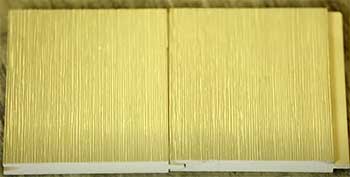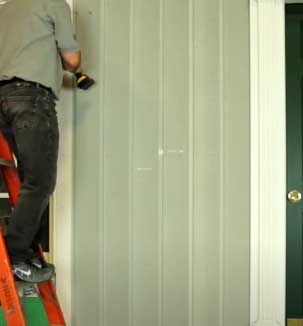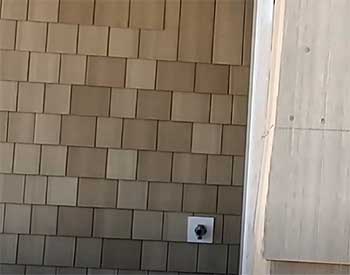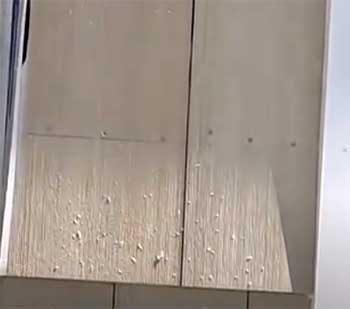NuCedar fiber cement siding has become a popular choice for homeowners looking to re-side their homes. Made from a blend of cement, sand, and cellulose fibers, NuCedar offers the look of real wood siding without the associated maintenance issues.
However, no siding product is perfect, and NuCedar does have some potential downsides. In this comprehensive guide, we’ll explore the most common NuCedar siding problems homeowners report and provide tips to prevent or fix them.
Common NuCedar Siding Problems
Here is a list of those issues:

- Fading and Discoloration
- Cracking
- Mold and Mildew Growth
- Chalky Residue
- Damaged Pieces
- Efflorescence
- Slow Installation
- Painting Difficulties
- Higher Cost
- Finding a Qualified Installer
Let’s elaborate those problems.
Fading and Discoloration
One of the top complaints about NuCedar siding is that the color fades, streaks, or discolors over time. This is especially noticeable on lighter shades like white or light gray. There are a few primary culprits when it comes to NuCedar fading:
- Sun exposure – Like any exterior building material, NuCedar is vulnerable to UV damage from sunlight. The sun’s rays can gradually break down the pigments, causing the siding to appear washed-out or unevenly faded.
- Moisture – Excess moisture from rain, sprinklers, fog, and dew can lead to uneven weathering and streaking on NuCedar siding. Areas of the siding that don’t dry out quickly are more prone to fading.
- Dirt buildup – Mold, mildew, and general dirt that accumulates on the siding over time can also lead to discoloration, especially in shaded areas that don’t get washed by rainfall.
To minimize fading problems:
- Choose darker, more fade-resistant colors if available. Medium to darker browns, grays, greens, and blues hold up better than light shades.
- Install siding on surfaces that receive direct sunlight for much of the day for even weathering.
- Carefully clean siding annually with a pressure washer to remove built-up dirt.
- Keep vegetation and irrigation sprinklers from excessively wetting the siding.
- Use trim pieces like fascia and corner boards in contrasting colors to minimize appearance of uneven fade.
If fade or discoloration does occur, the siding will need to be cleaned and potentially repainted or stained to restore its appearance. Be sure to address any moisture issues first before attempting to refinish.
Cracking
Hairline cracks may appear in NuCedar siding over time. There are a few likely reasons:

- Temperature changes – Like wood, the cement composite material expands and contracts with changes in heat and cold. Over many seasons, this can stress the siding and cause cracking. Cracks tend to appear around window and door trim and corners first.
- Settling – Normal settling of the home over the years may also lead to stress cracks in siding, especially near corners, openings, and joints.
- Nail holes – Cracks often originate from nail holes during installation. As the siding flexes, these can worsen over time.
- Improper installation – Large cracks and cracks that run the length of siding boards are usually due to installation errors like nailing too tightly, not allowing proper spacing between board ends, or inadequate framing.
For small hairline cracks, use a high quality flexible caulk or repair compound made for fiber cement to fill them in. Larger cracks may needbacker rods for support before patching. Severe cracking will necessitate replacing damaged siding boards.
To prevent cracks:
- Leave adequate installation spacing between siding board ends.
- Use siding hangers instead of nailing tightly.
- Install over solid, smooth substrate with house wrap.
- Avoid installing in extreme cold.
- Prime and paint all cut board edges.
- Caulk around openings, corners, and joints.
Mold and Mildew Growth
Mold and mildew growth are common problems for any exterior siding, including NuCedar. Mold spores landing on damp, shaded siding areas can generate black or greenish stains and mushy areas of damage. Contributing factors include:
- Excess moisture from leaks, rain splashback, lawn sprinklers, etc
- Lack of sunlight
- Poor ventilation
- High humidity
- Dirt and pollen buildup
To inhibit mold and mildew:
- Identify and repair any moisture sources like leaking roofs, gutters, or pipes.
- Trim back vegetation and landscaping from directly touching the siding.
- Use downspout extensions to direct roof water away from siding.
- Improve airflow by pruning dense bushes near the home.
- Routinely clean the siding with a pressure washer.
For minor mold/mildew, mix 1 part bleach with 3 parts water and scrub affected areas before rinsing. Severe cases may necessitate applying a mold-removing cleaner or replacing damaged siding boards.
Chalky Residue
A chalky white powder or residue may develop on the surface of NuCedar siding over time. This is caused by the breakdown of the top layer from weathering. It is generally an aesthetic concern rather than a performance problem. To remove a chalky residue:
- Use a pressure washer to clean the siding.
- Wipe with a damp cloth and mild detergent.
- For persistent residue, use an oxalic acid-based cleaner specifically for cement products.
Prevent future chalking by:
- Keeping the siding well-sealed and caulked.
- Applying high quality primer and paint when installing new siding.
- Maintaining the paint layer with touch-ups or full repainting every 5-7 years.
Also Read: Problems With Everlast Siding.
Damaged Pieces

Like any siding, NuCedar boards can become cracked, warped, or damaged over the years due to factors like weather, impact, improper handling, or underlying house settling.
Damaged pieces tend to stand out against pristine boards.
For minor damage like chips or gouges, use a siding repair compound to patch.
Heavily damaged boards may need complete replacement by cutting out and installing new ones. Take care to match existing overlap lines and seam spacing when replacing to get the proper fit.
Prevent damage by:
- Handling boards carefully during transport and installation.
- Leaving adequate spacing between board ends.
- Using proper trim pieces around openings and corners.
- Securing boards properly with hangers – avoid driving nails tightly.
Efflorescence
Efflorescence is a white, powdery deposit that can appear on NuCedar siding. It is caused when water evaporates, leaving behind salts and minerals from the cement that migrate to the surface. Efflorescence is generally more common during the first year after new installation as leftover cement cures.
To remove minor efflorescence:
- Let the siding dry out completely after rainfall or washing.
- Use a stiff brush or broom to scrub deposits after they fully form.
- Rinse cleaned area thoroughly.
For stubborn buildup, an acidic cleaner may be needed. Improve drainage around the home and repair any leaks to prevent excessive moisture triggering efflorescence. Maintaining painted siding can also minimize recurrence.
Slow Installation
Compared to other sidings like vinyl, NuCedar generally takes longer to install due to the need to cut each board individually and the extra care required around nail holes. This can drive up overall project time and labor costs. A few tips for more efficient installation:
- Use shears or a circular saw with a cement blade to cut boards. A power shear offers fastest cutting.
- Mark board layouts clearly on the walls for required sizes and spacing.
- Use hangers instead of nailing when possible to avoid cracking at nail holes.
- Stack installation layers from the ground using a telehandler instead of ladders.
- Ensure adequate bracing and smooth substrate for easy attachment.
- Employ an experienced siding crew familiar with fiber cement.
Painting Difficulties
Painting NuCedar siding can be more difficult compared to other materials like wood or vinyl. The surface is less absorbent and mistakes are costly due to the cement base. Potential issues include:
- New paint not properly adhering to the siding surface and peeling or flaking off. Always use dedicated fiber cement primer first.
- Uneven absorption leading to splotches or lap marks. Maintain wet edge and apply enough paint.
- Drips leaving thick edges that must be sanded off. Work bottom to top and use masking.
- Inability to permeate cracks or damaged areas. Seal with flexible caulk first.

To make painting easier:
- Clean siding thoroughly and let dry before priming.
- Apply fiber cement primer to create an absorbent base coat.
- Use high quality 100% acrylic exterior paint.
- Paint in dry conditions avoiding direct sun or high humidity.
- Maintain a wet edge and work bottom to top.
- Use an airless sprayer for fastest, most even coverage.
- Backbrush after spraying to work paint into surface.
- Allow proper drying time between coats.
Higher Cost
On average, NuCedar siding costs $6-9 per square foot installed. This is 2-3 times more expensive than basic vinyl siding. While NuCedar offers a good value for a wood-look product, the higher upfront investment can deter some homeowners.
Keep in mind potential cost savings from lower lifetime maintenance though.
Ways to keep NuCedar siding costs manageable:
- Shop around for best local installer pricing.
- Consider partial wraps or siding accent walls rather than whole house application.
- Use cheaper siding like vinyl on less visible upper floors.
- Opt for unfinished panels and stain or paint yourself.
- Seek installer discounts for bundling with window, roofing, or insulation projects.
- Use thinner width boards to reduce material requirements.
- Plan installation during contractor off-season for potential savings.
Finding a Qualified Installer
Re-siding is a major, technical project where proper installation is critical. However, many general contractors have limited experience with newer products like fiber cement. NuCedar siding requires expertise to:
- Make precision cuts, especially around openings.
- Space and align boards properly.
- Attach using hangers to avoid nailing errors.
- Follow proper caulking and sealing methods.
- Meet code requirements for structure, wind resistance, and fire safety.
To find a qualified installer:
- Ask suppliers for recommended installers who buy NuCedar regularly.
- Verify they have 5+ years experience with fiber cement specifically.
- Review examples of past fiber cement siding projects.
- Ask about training credentials from the manufacturer.
- Ensure they carry proper insurance for the job.
- Get multiple bids and check references before deciding.
While fiber cement siding offers many benefits, it does have some potential downsides to consider. Being aware of common NuCedar problems along with proper installation, maintenance, and repair methods allows homeowners to enjoy the look and performance of this popular siding material.
Reaching out to a siding specialist and using high quality materials also helps minimize any issues.
Frequently Asked Questions about NuCedar Siding
NuCedar is a popular brand of fiber cement siding designed to replicate the look of real cedar wood siding. Here are answers to some common questions homeowners have about NuCedar products.
On average, NuCedar siding costs $6-9 per square foot installed. This compares to $2-3 per square foot for basic vinyl siding. NuCedar is more expensive due to the cement composite material and more difficult installation. However, it requires much less maintenance than real wood siding.
Costs can vary based on your location, house size, contractor rates, finishes, and special installation requirements. Get multiple installation bids to find best pricing.
NuCedar siding consists of a fiber cement composite material blending cement, sand, cellulose fibers from wood pulp, and various proprietary add mixtures. This makes it more durable than wood while offering a similar natural look when painted or stained.
For routine cleaning, use a garden hose or pressure washer. Start at the top and work down methodically. Avoid high pressure streams directly at board edges to prevent damage.
For stained siding, a mild detergent and soft scrub brush can be used to remove stubborn dirt. Clean painted siding with a non-abrasive degreaser.
After washing, wet the surface gently with clean water and use a brush to lift dirt from grooves. Rinse completely with low pressure.
Properly installed and maintained NuCedar siding is expected to last 50 years or more. Real cedar wood siding has a shorter lifespan of around 20-30 years depending on weather exposure and maintenance.
Fiber cement lasts much longer than wood because it resists rotting, splitting, warping, and pests. Keeping NuCedar painted or sealed also extends its durability. Promptly repairing any damage prevents deterioration over time.
NuCedar requires minimal maintenance compared to real wood siding. Other than occasional cleaning, properly installed NuCedar needs repainting every 7-10 years. Stained versions require re-staining every 3-5 years.
Avoid spraying bushes, fertilizing, or excessive lawn watering near the siding. Direct roof runoff away with downspout extensions to prevent excessive moisture. Periodically inspect for damage and proactively seal gaps or cracks.
With proper care, NuCedar siding will retain its like-new appearance and protect your home for decades.
Closing Remarks
NuCedar fiber cement siding provides homeowners with an attractive and durable alternative to natural wood siding. Its cement-based composition offers increased longevity and resistance to rot, insects, and moisture damage compared to wood.
However, NuCedar is still vulnerable to issues like fading, cracking, mold growth, and installation difficulties.
Being proactive to properly install, finish, and maintain NuCedar siding helps minimize these potential problems. Seeking out experienced contractors familiar with fiber cement application is also advised.
With proper care and maintenance, NuCedar siding will enhance your home’s curb appeal and stand up to the elements for an expected lifespan of 50+ years.
Weighing the benefits against the potential drawbacks will help homeowners decide if NuCedar is the right siding choice for their replacement or remodeling project. For those seeking natural wood beauty without the maintenance, NuCedar remains an appealing option to consider.
